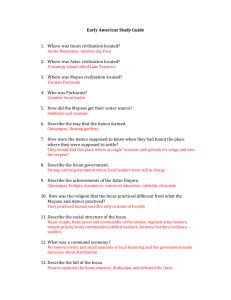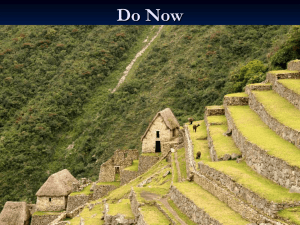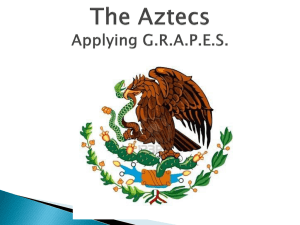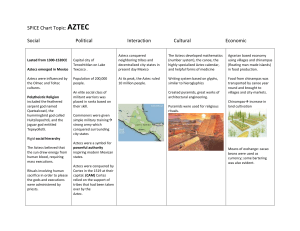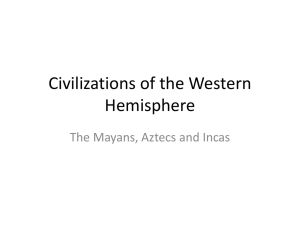Social Structure - Brookwood High School
advertisement
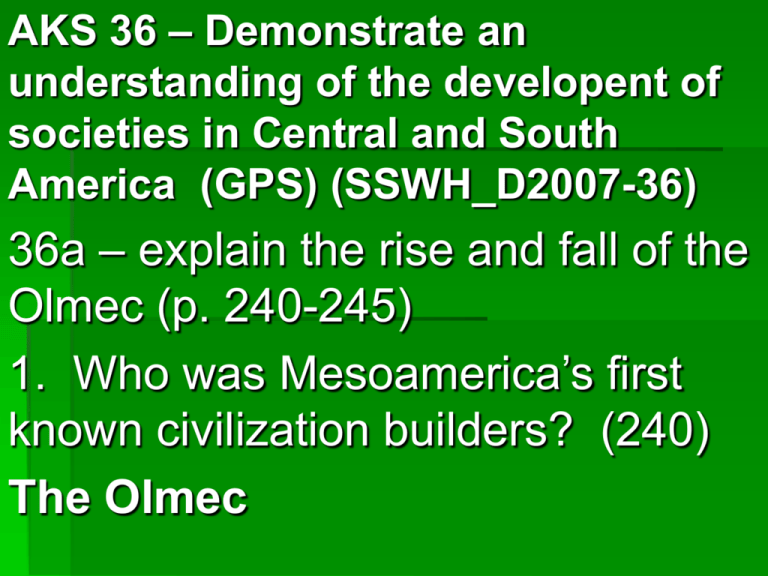
AKS 36 – Demonstrate an understanding of the developent of societies in Central and South America (GPS) (SSWH_D2007-36) 36a – explain the rise and fall of the Olmec (p. 240-245) 1. Who was Mesoamerica’s first known civilization builders? (240) The Olmec 2. What time period did the Olmec civilization emerge? (240) Around 1200 B.C. 3. Why were the Olmecs referred to as Mesoamerica’s “mother culture”? They were the first known civilization builders and influenced neighboring groups, as well as later civilizations of the region. Chart; (p. 240-245) Geography (where is it located and climate?) Jungles of Southern Mexico (Veracruz and Tabasco) (hot and humid) How did their civilization arise? Emerged around 1200 B.C. and thrived from 800-400 B.C. Had rivers, abundant natural resources, flooding provided fertile land for farming. Social Structure – Had rulers, gods (nature), worshipped Jaguar spirit. Very prosperous Trade – Abundant supply of salt, tar, clay, wood, rubber. Had largest trade network throughout Mesoamerica (Mexico City to the north and Honduras to the south.). Traded raw materials and various stones. Trade boosted the economy and spread Olmec influence. Decline – reasons unkown. Contributions – (legacy) “mother ritual” – Left behind art styles, ceremonial centers, ritual ball games, an elite ruling class and stone symbols that may have led to writing. First known civilization builders. Cuicuilco Some consider it the oldest pyramid on earth. 36a – Explain the rise and fall of the Maya, Aztec, and Inca Empires Rise and Fall of the Maya Traits of Civilization Religious beliefs and theocracy Independent city-states Intensive agriculture Strength Leading to Power United culture Loyalty to the King Wealthy and prosperous culture Production of more food feeds a larger population Weakness leading to Decline Many physical and human resources funneled into religious activities Frequent warfare occurs between kingdoms Population growth creates need for more land Tikal Chichen Itza Ruins, Maya Civilization, Yucatan, Mexico Maya Gods Rise and Fall of the Aztec Traits of Civilization Religious beliefs and theocracy Powerful army Empire of tribute states Strength Leading to Power United culture Loyalty to the Emperor Added land, power, and prisoners for religious sacrifice. Provides wealth and power and prisoners for religious sacrifice Weakness Leading to Decline Many physical and human resources funneled into religious activities Need for prisoners changes warfare style to less deadly and less aggressive Tribute states are rebellious and need to be controlled. Aztec Temple Tenayuca Skull rack or Tzompantli One of the greatest rulers of the empire was Ahuitzotl (ah WEE soh tl). From 1486 until his death in 1502, he led Aztec armies in conquest throughout Mexico and Central America. He made lightning-quick attacks that took his enemies by surprise Ahuitzotl also completed the pyramid of the Great Temple, which he dedicated to the god Huitzilopochtli. When Ahuitzotl died in 1502, his nephew, Monteczuma, became the new ruler. Aztec social structure Two most important Aztec gods were Tlaloc god of rain Huitzilopochtli , god of sun and war Aztec weapons Tenochititlan Tenochititlan Rise and Fall of the Inca Traits of Civilization Religious beliefs and theocracy Major road system Type of welfare state with huge bureaucracy Strength Leading to Power United culture Loyalty to the Emperor Roads connected entire empire and aided control Care for entire population during good and bad times Weakness Leading to Decline Many physical and human resources funneled into religious activities Enemy could also use roads to move troops People struggled to care for themselves with elimination of welfare state Macchu Picchu Incan Skull surgery Puente del Inca – Bridge of the Incas Sacred Valley of the Incas Fighting Pizzaro’s troops Lost City of the Incas Hiram Bingham-inspiration for Indiana Jones Incan Emperor Sacred Valley of the Incas Sacred Valley of the Incas- Ollantaytambo Valley of the Incas 36b – compare the culture of the Americas including government, economy, religion, social structure, technology and the arts of the Mayans, Aztecs and Incas Mayans (p. 446-451) Geography – Southern Mexico and northern Central America- Cool cloudy mountainous Yucatan Peninsula (steamy jungles) Social Structure – Top of Society; King Nobles Leading warriors Middle; Merchants and people with specialized knowledge such as artisans Bottom; Peasant majority Contributions of the Mayans; Had the most advanced writing system in ancient America (Hieroglyphic symbols) aka, glyphs. Developed bark-paper books, developed a calendar, were gifted in math, used the concept of 0.0, (decimals) and studied astronomy (calculated the solar year at 365.242 days – only .0002 off.) Religions of the Mayas; Polytheistic, prayed to gods Gave offerings of food and flowers and incense. Practiced human sacrifices to the gods. Government of the Mayans; Independent city states Theocracy Economy; Agriculture and trade City-sates linked through trade alliances Agriculture-particularly maize, beans, and squash Technology; Math concept of 0. Calendar Astronomy City building Slash and burn faming Sophisticated planting on raised beds above swamps and on hillside terraces Arts; Hieroglyphics – 800 symbols Sacrifices Pyramids Ball Courts for religious games Jaguar architecture Stele’s (Inscribed markers) Aztecs (p. 452-458) Geography; Tenochtitlan – capital Modern day Mexico City Built on an island on Lake Texcoco Social Structure of the Aztecs; Emperor Nobility - Government officials, religious leaders Commoners – merchants, craftspeople, soldiers, farmers who owned land Slaves Contributions of the Aztecs; Causeways over water. Floating gardens Two calendars believed to have been derived from the Mayans Aztec Sunstone Religions of the Aztecs; Polytheistic, public ceremonies, human sacrifices Founded their capital city based on the Aztec legend of Huitzilopochtli (god of the sun and warfare) Over 1,000 gods Elaborate public ceremonies to win favor of different gods. Ritual dramas, songs, and dances The Aztecs believed the Sun god Huitzilopochtli needed nourishment of human blood for the sun to rise. Government of the Aztecs; Small city states Military State-Triple alliance in 1428 divided Empire into 38 provinces with 5 to 15million population. Economy of the Aztecs; The government ruled loosely over the empire making conquered areas pay tributes. If people resisted tributes or revolted, Aztecs would destroy village and capture or slaughter it’s inhabitants. Trade connected by water and canals so canoes could bring products directly to cities Technology of the Aztecs; Tenochtitlan was a planned city greater than any in Europe of the time Engineers built causeways over marshy land and water. Floating gardens (Chinampas) built on marshy fringes of the lake. Aztec Art; Temples Pyramids Stone carvings and paintings for the gods. Masks for religious rituals Incans (p. 459-465) Geography; Largest empire in the Americas Most of the West coast of South America from Ecuador to Chile Social Structure of the Incas; Based on community cooperation Allyu (extended family group that would undertake tasks too big for the single family). Divided family in groups of 10, 100, 1000. A Chief led each group. Local administration in the hands of local rulers. Conquered peoples were allowed to continue their traditional ways of life. Peacefully conquered peoples to gain their loyalty whenever possible. Incan Social Stucture con’t Incans imposed a uniform single language throughout their empire Social groups identified by officially dictated patterns on clothing. Contributions of the Inca’s; Uniform architecture throughout the empire Took care of indigent and elderly Freeze dried potatoes (chumo) Gov’t storehouses for times of famine and shortages Public works ie..1400 mile network of roads and bridges. Guest houses for travelers Contributions of Inca’s (con’t) Postal service Quipi knotted strings to record data Never developed a writing system Everything was oral Religions; Two calendars-one for night, one for day Believed gods ruled night and day Reinforced power of the state Creator god – Viracocha Sun god - Inti Viracocha Incan Religions Mamakuna-”Virgins of the sun” Committed to lifetime of religious service, religious activities, teachers, spinners, weavers. Yamacuna- men- workers for the state and to aid in religious activities. Incan Government; Largest Empire in western hemisphere Had to be a descendant of Inti to rule Had 80 provinces and about 16 million people. Conquest was through diplomacy and military force. Large bureaucracy Tributes were paid with labor. Compatible to socialism today. Incan Economy; Efficient system Extensive road system to tie empire together. Regulated production and distribution of goods throughout the empire. Incan Technology; Masterful engineers and stonemasons No iron tools or wheels or mortar Incan Arts; Temple of the Sun in Cuzco (religious capital)-most sacred shrine covered in gold Gold covered walls in city and was extremely abundant.
